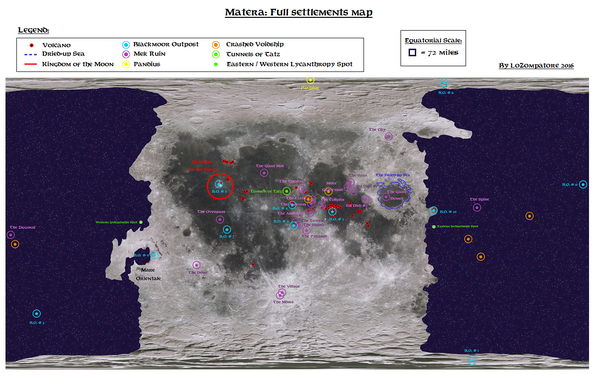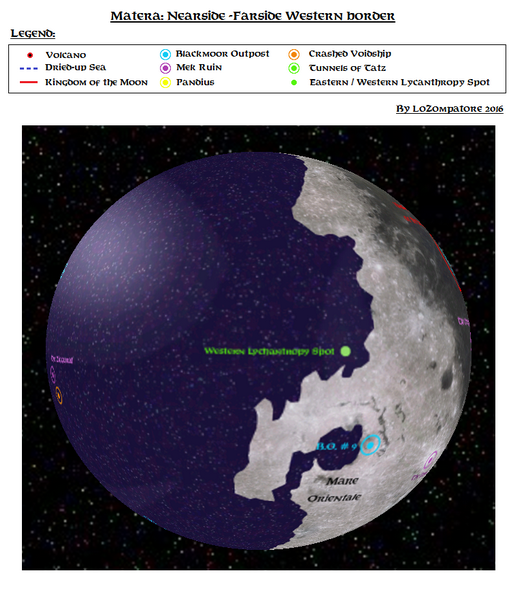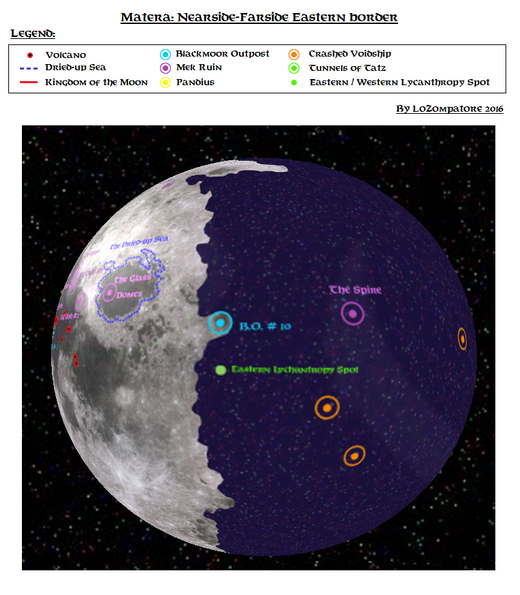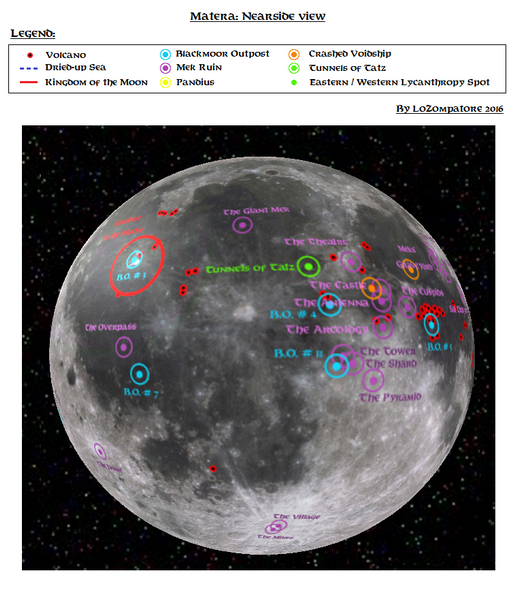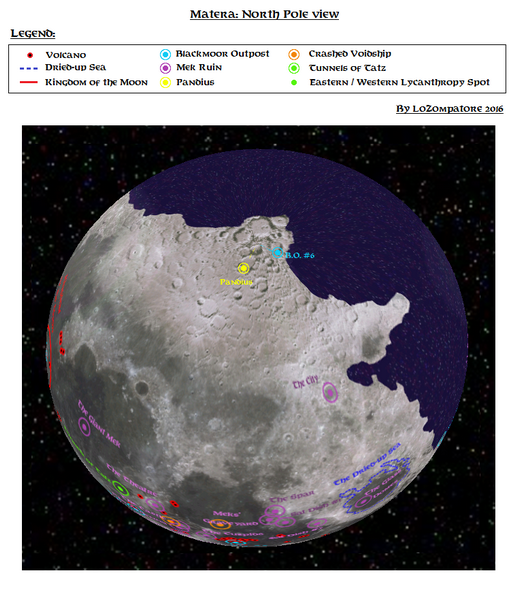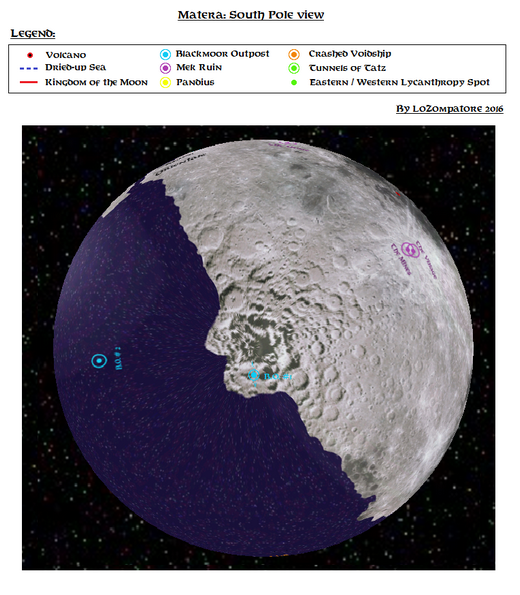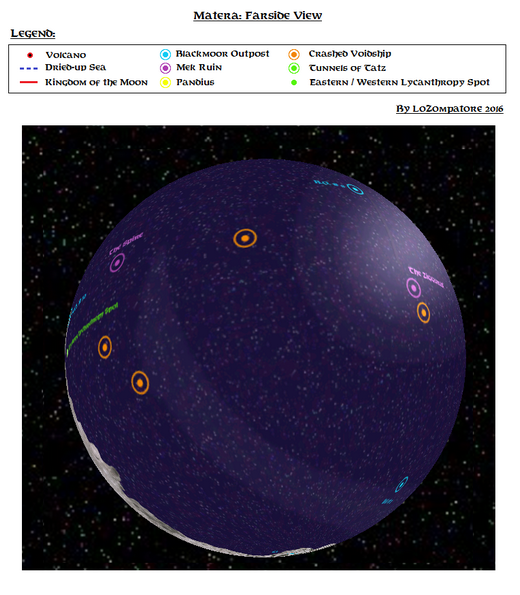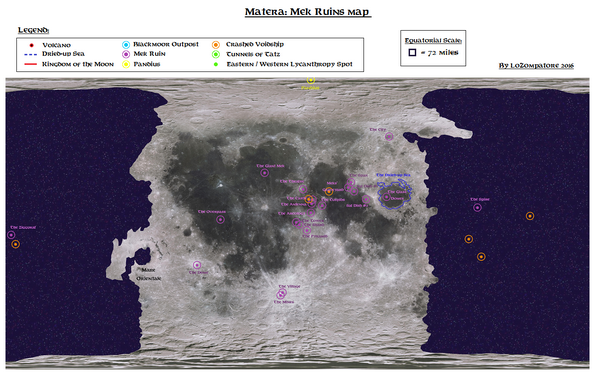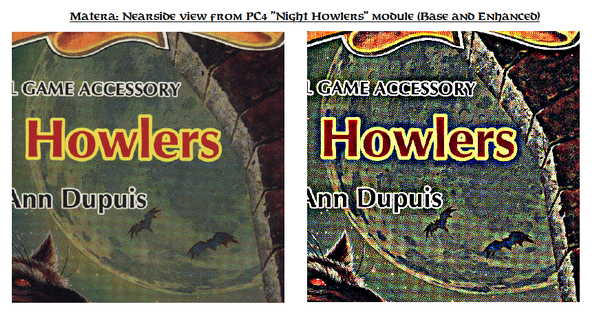
Revamping Matera
by LoZompatoreWhen talking about Matera I must admit that I don't like the established view of a totally lifeless moon. I feel as a major disappointment that one of the nearer and more easily reachable worlds outside Mystara is so uninteresting for adventurers and DMs alike.
I also believe that the common objection that Matera is lifeless because it hosts the Immortals' city of Pandius doesn't hold, as in WotI (Codex of the Immortals book) it is clearly stated that Pandius is located in its own pocket universe, which is invisible and unreachable to mortals if the Immortals do not want to. It is even stated that it is possible to walk on the surface of the very lunar crater in which Pandius is built without perceiving anything different from the average lunar landscape.
Moreover, a few hints here and there on various supplements (X4, CM4, CoM Designer's Manual, I11) suggest that Matera may not be so devoid of life.
By using the information in the modules, and incorporating them with other fanon material found on the Vaults (plus some original work of mine), I drafted an annotated list of the possible settlements or interesting places on the surface of Matera. Just to spice things up a bit.
In the article I followed the basic approach that Matera is identical to the real Moon (main physical features, craters, landmarks, etc.) except where canon or fanon information dictates otherwise. This approach enables setting some locations with relative ease, as detailed below.
The Hollow Moon
As a starting point I fully buy the concept of the Hollow Moon by Sharon Dornhoff (see here for an introduction). Basically, Matera is hollow and the far side of the moon does not show craters or regolith but, instead, is made of a smooth, demi-transparent shell across which most sunlight may lit the interior every lunar day (which lasts for 14 Mystaran days).
Features on Matera's Nearside are identical to the real Moon, while the elevation profile is multiplied by a factor of 10 with respect to the real Moon (i.e. a trench 3 feet deep on the real Moon is a gorge 30 feet deep on Matera, and so on). As an option I guess such multiplication may decrease with elevation, otherwise the highest mountains of Matera could come up with a total height of 29 miles!
As a rule of thumb I would suggest the following progression:
- multiply heights by a factor of 10 up to 1000 feet
- then x5 between 1001 feet and 2500 feet
- then x2 between 2501 feet and 7500 feet
- and finally x1.5 for 7501+ feet.
This would pretty much modify the elevation profile of Matera with respect to the real Moon and introduce a lot of new mountains, but the highest points would always stay below 4.7 miles (7.5 km) which sounds pretty good to me.
According to Sharon Dornhoff Matera is also much more geologically active than the real Moon, even if most of the activity is diverted to the internal surface rather than to the external one. While such activity helps explaining the increased number of mountains and their higher elevation profile with respect to the real Moon, this also means that inside the crust it is possible to find heat, energy, light and, likely, water.
Most interesting, I guess that isolated active volcanoes and related lava flows might also be found on the external surface. By using as a reference this article on the web I assumed that all volcanoes shown on the map are active as of AC1000. As the map does not cover the whole surface of Nearside, I guess that with further research (or if you feel convenient to do so) it is possible to add more active spots.
On a side note, thanks to the emissions from all these volcanoes, the atmosphere on Matera should not be so thin to resemble a void (as per the real Moon) but it should more likely resemble the atmosphere of Jupiter's moon Io. This means that Matera's atmosphere is approx. 10'000 times denser than the real Moon, but still around 1 billionth of the density of air at sea level on Mystara. This atmosphere is made of not breathable gases, but it may support gaseous forms and, given a couple of centuries of patient collection of gases and vapors, it should be even possible to summon an air elemental on the external surface.
For the rest, Chimpman already gave a very clear introductory description of the Hollow Moon main features on Threshold Magazine Issue #2 so I do not replicate it here.
Adding features to the map
As a small contribution to the Hollow Moon Project I just add here a global equirectangular map of the external surface of Matera according to the Hollow Moon description.
Starting from this map I added some features and settlements which I'll discuss in greater detail below.
The equirectangular map of Matera with all the features I added is shown below:
Some rotating globe frames of Nearside and Farside of Matera taken at notable points of view are shown below:
What follows is a detailed description of all features shown in the maps above.
An ancient sea
I'd add the dried-up remnants of an ancient small sea in the deepest part of Matera's Nearside (the equivalent of the real Moon Mare Crisium). This is inspired by the following sentence of Companion Set (DM's Book, page 19):
Moons, comets, and other large moving bodies on the Prime Plane rarely have any elemental connections. They are sometimes created by temporary wormholes, which break when the corresponding body on the Elemental plane moves out of position. In a similar manner, a vortex may suddenly appear on a moving body, as a corresponding moon “nears it” on the Elemental Plane. For example, an ocean could suddenly appear on a moon near the characters’ world!
This dried-up sea might have been the main water source of the mek civilization (see below), or it might have been created by some planar alignment long after the disappearance of the meks. Whichever its history, the area is now a dry plain covered with salt. Pockets of water may be sealed below the surface and inhabited by water elemental creatures stranded on the moon (or still in contact with their home plane) and struggling to prevent their habitats from drying up.
Settlements and artificial features
Now, let's talk about artificial features and other settlements on the external surface of Matera. First of all I'll go with the general approach described in Champions of Mystara - Designers' module:
"DMs wishing to liven up Matera a bit may place unknown, secretive, and very reclusive underground creatures on the moon. Or explorers looking past the uninspiring exterior of this "lifeless chunk of rock" might find evidence of long-lost civilizations here."
So, we could have underground secretive cultures on the interior and the remnants of long-lost civilizations on the exterior surface. Voidship wreckages are a bonus.
A possible - but likely not complete - list could include:
Underground secretive cultures:
- The planar spiders of Chak and Black Chak living in the Tunnels of Tatz
- The Kingdom of the Moon
- Galeb Duhr settlements (if any)
Ruins of lost civilizations:
- Abandoned Blackmoor Outposts
- Ruins of an ancient mek civilization
The Tunnels of Tatz
Info about the Tunnels of Tatz comes from I11 module "The Needle", an AD&D adventure by Frank Mentzer. This module details how the planar spiders of the nations of Chak and Black Chak established a subterranean trading outpost called Tatz on an airless and (almost) lifeless moon of the PC's world. As Chak and Black Chack are mentioned also in the "Monstrous Compendium: Mystara Appendix" supplement, then I guess I11 could be set on Mystara. The airless moon would obviously be Matera.
According to the module, the tunnels of Tatz are at least 2.5 miles in diameter. The outpost is techno-magically connected to at least a couple of locations on Mystara and, very likely, to other similar outposts across the planar spiders trading network on the Prime Plane. The planar spiders are friendly and would like to trade with the Mystarans. They already tried in the past, but the frog men they contacted in the ast became soon involved in a civil war so the trading hub was closed off. Even if the planar spiders would like to renew their business on Mystara they do not seem to care very much about the waiting, as they are very likely supported by the rest of the huge interstellar network of their kin.
A possible location for the Tunnels of Tatz could come from the following excerpt of I11 (the PCs' party is invited to see the external surface of the moon from an observation cupola):
"The surface area outside the dome is visible once the dome cover has retracted. The bleak and barren moonscape is marked by huge mountains, inky black shadows, and a total lack of vegetation, water, or anything else but rock. The dome itself is a glassy substance, barely visible. There is no air outside of it."
We could say that this location is not far from the highest mountains of Matera, which should be placed inside the equivalent of the Apennine Mountains of the real Moon.
An interesting location would be somewhere on the plains close to the Northern Apennine Mountains, where canyons from collapsed lava tubes are also present (see this picture here).
Other, not-collapsed lava tubes below the plain may form the backbone of the tunnel network of the planar spiders, which is constantly enlarged and modified by the Chompers (a variety of purple worms trained by the planar spiders) brought on Matera by the people of Chak.
Moon rocs and Galeb Duhrs
Also of interest are the galeb duhrs and the moon rocs living on the moon surface, also according to I11.
Moon rocs are said to have been created from common rocs by a mad wizard. Their breed was magically adapted to live and fly in the airless and hostile environment of the surface. They feed on sunlight, which they adsorb through their wings and are neutral in alignment.
Galeb duhrs are said to be reclusive but well adapted to the lunar environment, they inhabit both the surface and the tunnel systems beneath. Sometime they are used as guards or spies by the planar spiders of the Tunnels of Tatz. No details are known about their society but, given their high intelligence level, they should very likely possess a sophisticated culture. Together with their camouflage skills I believe that galeb duhr should be quite widespread on Matera: they could likely be the most common intelligent life form on the moon, albeit difficult to detect.
The "Monstrous compendium: Mystara appendix" (page 47) states that geonids may be related to galeb duhrs but they rarely are found in the same place. So, what if the geonids are a strain of galeb dhurs who was stranded on Mystara and evolved independently? In particular, geonids (or their distant, galeb duhr-like ancestors) might have reached the Black Mountains through the Well of the Moon (described in X5 module The Temple of Death; see also below).
Blackmoorish settlements
In most fan-made material there is pretty much consensus about the presence of Blackmoorish outposts on Matera, established during the golden age of this empire. Blackmoor was a techno-magic civilization definitely more advanced than our one, and we already set foot on the Moon so, in my opinion, this assumption is fairly admissible.
There is also the following hint from an official supplement (CM4 "Earthshaker!" module, page 10):
"Milos doesn't know who built Earthshaker but he knows that it was built at least 3000 years ago probably by a race of evil gods similar in skill to dwarves or gnomes. Legends tell of an evil giant named Morag who threatened to conquer not just the world, but the sun and moon also. These gods sired the hero Zarka who defeated Morag by trickery and stole away the gem containing his soul. Without his soul Morag hardened and became a mountain of iron.
Milos discovered Earthshaker on one of his collecting expeditions for the princes of Glantri, deep in the wild mountains far to the west. He persuaded the gnomes living in the behemoth to return with him to Glantri."
We could assume that the Earthshaker is a creation from the Blackmoor age (notice that the "3000 years ago = 3000 BC" mistake is fairly common in early official supplements), so the sentence above means that people from Blackmoor were definitely able to reach the moon (Matera) and also Mystara's sun.
Notice also that the quoted paragraphs above hint at a civil war in Blackmoor, as the same creators of the Earthshaker were obliged to hire a hero in order to defeat the machine once it (and its master) rebelled against them. I especially like the idea of such a civil war because in the Dragonlord Trilogy - Book 2 it is said that the mages of Blackmoor emptied the fortress of Dragonwatch Keep form all its powerful weapons in provision for some kind of war shortly before the Great Rain of Fire (such weapons were neven brought back to the fortress).
While the civil war should not be the direct cause of the Great Rain of Fire (as it is said in many official supplement that the cataclysm was "accidental") I guess that the idea of such a conflict shortly before the disaster may help in explaining a few things (such as why the off-planet colonies were not able to help in the rebuilding).
Said so, let's assume Blackmoor placed several outposts on the surface of Matera over the last few centuries before the Great Rain of Fire. A good timeframe for lunar colonization, in my opinion, could be from 3300 BC to 3000 BC. As the choice for the placement and use of such outposts should mainly come from scientific rationale, I think that most locations can be taken from NASA's and other space agencies' studies.
That's the choice behind the list of the 11 ancient Blackmoor outposts shown below.
Numbers refer to the order of settlement, from the earliest to the latest. References come from this pdf document and this website on Lunarpedia. I added also a brief summary of the main use and characteristics of every outpost. Again, most info were taken from the references above, while I added a few more entries related to the specific features of Farside, the Hollow Moon, active volcanoes and the presence of nearby ancient ruins (see below for the latter).
Notice also that with the term "Blackmoor Outpost" I also include any colony established by the elves of Evergrun or other ally of the people of Blackmoor.
1) South Pole (rim of Shackleton crater) - Energy and water production; geology
2) Aitken Basin floor - Study of the crystal shell on Farside
3) Aristarchus Plateau - Geology; geothermal energy; main population center of the Blackmoorian outposts
4) Rima Bode vent - Mining site; geothermal energy; exploration of mek ruins
5) Arago Crater in Mare Tranquillitatis - Geothermal energy, geology, mining and space science; exploration of Mek ruins
6) North Pole (rim of Peary B crater) - Energy and water production
7) Flamsteed crater in Oceans Procellarum - Geology and mining site
8) Dante crater - Astronomy; outpost for Farside exploration and distance exploration of the Hollow Moon interior
9) Kopff crater (rim of Mare Orientale) - Geology; exploration of Mare Orientale and the entrance point to the Hollow Moon
10) Peek crater in Smythii basin - Geology, mining and astronomy; outpost for Farside exploration
11) Sinus Medii (close to Bruce crater) - Main energy receiver for the Lunar Outposts' network and base site for Mek ruins exploration
Such locations are shown in the map below:
We could say that Blackmoor established its first outpost on Matera's South Pole, where sunlight and water ice were present, around BC 3300. A new outpost could have been established, on average, once every 25 years.
Of course, the Blackmoorians became well aware pretty soon of the real nature of Matera (the Hollow Moon and the crystal covering half of the surface) so they established outposts also on Farside, to study the crystal shell and to peek into the Hollow Moon from the outside.
Most Blackmoorian activity on Farside would have been aimed to enter the hollow space of the interior and to reach the lands they could only see from outside. We could use Sharon Dornhoff's fluff here and say that their main attempt to reach the interior through the crack in Mare Orientale ended in disaster, while I personally prefer such events to be placed one or two centuries before.
Outpost #11 is the last one established by the Blackmoor civilization before its fall, maybe as late as a generation before the Great Rain of Fire. I figure it as the most technologically advanced settlement, aimed to collect microwave energy from a dedicated orbiting station and distribute microwave energy to the network of colonies (the idea comes from the article on Lunarpedia referenced above). Thanks to its critical role in supplying extra energy to the rest of the settlements, I suppose that this outpost, by the time of its establishment, would become the de-facto "capital" of the Blackmoorish Materan colonies and the main target for any aggressor during the civil war.
Outpost #3 is located in the middle of a very interesting volcanic area. On the real Moon the region surrounding Aristarchus crater is close to a large volcanic plateau approx. 200km across rising more than 6500 feet (2 km) above the surrounding lunar mare (applying the increase in elevation suggested in the introduction the same plateau on Matera would rise up to 13000 feet, or 4 km in elevation). This area likely crisscrossed by an extended network of underground, well protected, lava tunnels up to 500 yards (approx. 500 meters) in diameter and dotted with natural vents to the external surface.
For these reasons I supposed that its equivalent on Matera would have been a suitable place for a large settlement, likely the main population center of the whole moon, hosting a great part of the total number of Blackmoor colonists. Technology could have enlarged the tunnels to create artificial habitats - according to the Dragonking of Mystara book the pre-GRoF, ancient dwarvish city of Darmouk in Rockhome was built under an artificial dome 5 x 2 miles wide (see here for details), so similar achievements on Matera were not impossible to the Blackmoorians.
Said so, let's go back to the civil war started by Morag.
Let's say that all the outposts on Matera were attacked by Morag and its followers, and that the Blackmoor Empire retaliated trying to conquer back all settlements. Now, lunar outposts are a fragile thing. It is very likely that warfare on any of them resulted in the total destruction of the life support system. I guess that most, if not all, of the colonies were destroyed or evacuated by the end of the civil war. A possible exception would have been the large Outpost #3 on Aristarchus. Thanks to its extent and its subterranean nature this colony could have survived an external attack and, in general, the civil war.
We could say that this settlement, while crippled and badly damaged, did not fall. Survivors spent the next few years trying to repair damages and contact the other colonies and the Blackmoor Empire on Mystara. Survivors of the other colonies could have been moved to Aristarchus waiting for the rebuilding of their settlements by the Blackmoor government.
Unfortunately, the survivors on Matera were nothing more than horrified viewers of the Great Rain of Fire and they could not offer any significant help during the aftermath. Later on, Immortals' meddling should have removed the technological support of the colonists and the life support system were substituted by its magical equivalent, and by modifications to the environment promoted by the Immortals.
I like to link the descendants of these survivors to the inhabitants of the Kingdom of the Moon described later on this article. The Well of the Moon may be the magic conversion of some technological device the colonists used to contact the world of Mystara before and shortly after the cataclysm.
The other Blackmoor outposts on Matera as of AC1000 would be radioactive craters or empty shells devoid of life and activity (maybe...).
Ancient ruins
Important Note: I know that there are some ufologists surfing on the web and looking for this kind of works to fuel support to their claims about aliens and ancient ruins on the real Moon. So, I want to be clear and state that what follows is a fictional composition related to a very specific setting for a specific role-playing game and that it does not intend to endorse anyone's beliefs about what is (or is not) located on the surface of the real Moon.
Said so, let's talk about ruins on the surface of Matera different from the abandoned Blackmoor's outposts.
This is definitely non-canon, but I really liked to expand on what Cab already wrote on the Vaults (see here) about an ancient war fought on Matera between a mighty civilization of hive-mind beings ruled by an Immortal-like creature called Hallucigenia and the other Immortals.
This ancient war, in which the hive-mind beings heavily used meks for fighting, gave Matera its current barren status, and Pandius was built above the most war-torn place.
Now, such a scenario allows for a lot of mysterious ruins scattered across Matera's surface. I'd like to take inspiration from the old concept of "lunar anomalies": various marks and signs on the low-res photos taken from the first lunar probes of the '60s and '70s. Many of them were interpreted as mighty buildings and other impressive artificial features so, why don't give them a try on Matera?
On the web there is a lot of ufology/debunking sites describing lunar anomalies. A few references I used are here, here and here
A selection of possible ancient ruins is listed in alphabetical order below (feel free to do your own research and add more). I gave them the same names provided by the ufologists, even if a few (the Giant Mek, the Theatre, The Meks' Graveyard) were created by me. Their real original use and purpose might match their description or be entirely different, up to DMs discretion.
Most ruins are huge (spanning some miles across) and made of glass-like, crystal-like or stone-like material.
- The Antenna (twisted remnants of a large paperclip-like structure 1.5 miles long)
- The Arcology (shattered remnants of a multi-layered, glass-like dome several miles across)
- The Castle (a floating, six-mile high, large structure made of huge columns)
- The City (ruins of a large city)
- The Cuspids (huge columns)
- The Dome (a glass dome supported by spider-like legs)
- The Giant Mek (an inactive giant mek standing on the plain)
- The Glass Domes (a group of crystal-like domes, possibly waterproof)
- The Meks' Graveyard (an area littered with thousands of body parts of meks)
- The Mines (abandoned strip mines with angled terraces, debris and rock piles)
- The Overpass (a long, bridge-like structure)
- The Pyramid (ruins of a pyramid half a mile high)
- The Sat Dishes #1 and #2 (huge structures, six miles large, similar to satellite dishes)
- The Shard (a tower-like puffy structure some 1.5 miles high)
- The Spar (ruins of a huge support strut for a larger glass dome)
- The Spire (a slim tower some half a mile high)
- The Theatre (a tall, D-shaped wall surrounding a meeting area)
- The Tower (a slim, puffy structure half a mile high below a floating cube half a mile across)
- The Village (ruins of a small settlement close to the Mines)
- The Ziggurat (a square ziggurat, 1-mile long)
The approximate locations of these ruins are shown in the map below:
Quod and Parquossia
In X5 module "The Temple of Death" is introduced a "Kingdom of the Moon" reachable through a magic well (the Well of the Moon) in the Black Mountains. As the Well's magic powers are also related to lycanthropy I guess that the Kingdom should be located on Matera.
In this module the Kingdom is up to the DM to be developed. Nevertheless, the same module introduces also the locations of Quod and Parquossia, which were never placed anywhere on Mystara in later products. So, why not going on with the identification: "Kingdom of the Moon = Quod + Parquossia"?
What follows is mostly a copy and paste of a possible theory of mine taken from the following post at The Piazza Message Board.
First of all, let's exploit the following quote of the Diaries of Quod (from X5 module encounter "B" above):
Aldisious of Parquossia writes of one of his travels: ‘While traveling through the Mountains of Anthropomagi, I found a tribe whose god was called the Living Light. At their behest I was taken to their shrine, where I observed a well, the walls of which were coated with an icy radiance that shifted and moved in my presence. Before being conducted to a closer examination of the well, Don Hesquirot and his knights prevailed on the tribe by force of arms to allow us passage through their lands. What examination I was allowed supports my opinion that the light was a product of a mixing of mineral oils and rare earths in the bowels of the earth. Whether the light was living or intelligent I could not tell. Since my return, I have not been able to copy the effect in my workshop.
It could be assumed that the glowing light is actually a creature from the depths of Mystara's crust (it is an "alien" just because it was never seen before so close to the surface). Notice that this creature is "new" to the surface, so also the Diaries of Quod and the expedition of Aldisious of Parquossia are both recent accomplishments.
Given the location of the Great Pass - and the information on surrounding regions accumulated on the other official supplements - places like Quod (which is likely a country) or Parquossia (likely a city) should be located in not-detailed areas surrounding Hule, most likely the north or the west. Nevertheless, both locations are not very satisfactory as - from the little available canonic info - the west should be an arid/desert land with little human population, while the north should be inhabited by barbarians. As people from Quod/Parquossia, seem to me pretty much sophisticated people (at least at a Middle Ages/Renaissance development level) I don't think .
Moreover, it is not very easy to explain how an exploration party with an armed escort ("knights" are mentioned) managed to reach the Great Pass (and come back) shortly before the Master's invasion of the eastern lands.
So, why not assume that Quod is the Kingdom of the Moon and Parquossia one of its cities? In this way the expedition of Aldisious actually managed to reach the Great Pass from the Moon through the magical stair, thus bypassing all the Hulean armies, the humanoids of the Black Mountains and the Abbey of Evil. The red dragon guarding the Well of the Moon would have been placed here by the people of Quod.
Notice also that, according to X5 module, the excerpt from the "Diaries of Quod" is available to the player characters only through a "commune", "wish", or "contact higher plane" spells, so this bit of information is not so easily accessible to the people of the Known World. This could be explained if the report was written by people living far away and who returned back once they completed their exploration.
Location of Pandius
What about the location of the Immortals' city of Pandius?
From Champions of Mystara, Designer's manual (page 35) we know it is located in a crater:
"the gateway to the Immortal city of Pandius, located in one of Matera's large craters"
From WotI book I, "Codex of the Immortals" we also know that Pandius is a pocket universe in itself, detached from the Prime Plane surrounding Mystara, and that this pocket universe cannot be detected by mortals if the Immortals do not want to. It is even possible to walk on the same lunar soil in which Pandius is located without finding any evidence of the city of the Immortals.
Said so, it is still possible to place the city on Matera's surface. In the last page of WotI "Codex of the Immortals" it is possible to see a picture of Pandius with Mystara low on the horizon. This immediately tell us that Pandius is on Nearside (the face of Matera looking at Mystara), but more information can be inferred. As Matera is tidally locked to Mystara, it always shows the same face to the planet. This means that every point on the surface of Matera's Nearside sees Mystara at a fixed elevation in the sky: observers located on Matera's equator see Mystara right above their heads, while people at the poles see Mystara very close to the horizon, as in the case of the picture from WotI. Pandius is thus located close to the north pole of Matera.
A more precise estimation of its latitude can be done as follows.
By using the official diameter of Mystara (3095 miles) and the distance between Matera and Mystara (206000 miles, corresponding to an orbit of 28 days around Mystara) the angular diameter of Mystara as seen from Matera can be quickly evaluated as 1.7° (slightly lesser than the angular diameter of Earth from the Moon, which is between 1.5° and 2.0°). This means that the size of Mystara's globe in the picture from WotI represents an angle of 1.7°.
With a quick comparison, it is possible to estimate the height of Mystara above the horizon in this picture as approx. 2.5°.
Given the great distance between Mystara and Matera the latitude of Pandius is approx. 90° - 2.5° = 87.5°. A more precise calculation provides the same results.
Said so, and keeping the similitude between Matera and the real Moon, I believe that a suitable location for Pandius would be inside Matera's equivalent of Peary Crater (see also here) which is pretty big (49 miles in diameter) and also includes both peaks of eternal lights both pools of eternal darkness filled with frozen water. I like the idea of such a striking contrast of light, temperature and elements contained in such a short distance. I feel it is suitable to represent the different attitude of the Spheres of Life and the Sphere of Entropy with regard to the universe.
Notice, by the way, the similarity between this simulated landscape of the areas surrounding the peaks of eternal light on the real Moon (see here) and the picture showing Pandius and Mystara at the end of WotI.
Lycanthropy
I don't want to delve too much in detail about the real origin of lycanthropy. PC4 module Night Howlers provides an explanation by saying this curse is due to a mutated strain of a magical virus sensitive to Matera's light. Whatever the origin, it only works when the moon is full. I think there are two possible choices for its triggering:
1) - The total lit surface of Matera as seen from Mystara must be above a given amount. This amount is very close to 100% of the total surface of Nearside, that's why it works only during full moons.
2) - There are two spots on both ends of Matera's Nearside which send some sort of "lycanthropy signal" to Mystara when they are both lit by the sun. This is possible only during full moons. I called these places "Eastern Lycanthropy Spot" and "Western Lycanthropy Spot", respectively.
I showed the locations of the two special spots just in case someone wishes to go for option #2 and use them for some adventures in search of the origin of lycanthropy.
Alien voidships
The idea of alien voidships crashed on Matera comes from this sentence of Champions of Mystara - Designer's Module:
"How about the wreckage of Voidships that undertook the perilous voyage from distant world only to crash on an inhospitable moon within sight of a magnificent world?"
I added the location of a handful of alien (or mek) voidships crashed on Matera. Many more sites may exist elsewhere on the surface.
The positions of the sites shown on the map correspond to the same locations of the real Moon in which ufologists spotted hypothetical crashed starships.
I do not give details based on the real world spotting as the voidships of Mystara's setting might be very different vehicles from the usual UFOs we are familiar with. It is up to the DMs to develop such places and their potential inhabitants.
An alternate external surface for Nearside
As you know well, so far the external surface of Matera is supposed to be identical to the Real World Moon. Actually it could be possible to use a detail from the cover of PC4 module "Night Howlers" which shows approx. half of the external surface of Mystara's moon. The image below shows the relevant detail and a slightly modified version with an (hopefully) enhanced contrast.
Maybe it could be possible to create some kind of (incomplete) equirectangular map using this picture as a reference.
Well, that's about all! Hope you enjoy it and that this material might be useful for further development.
